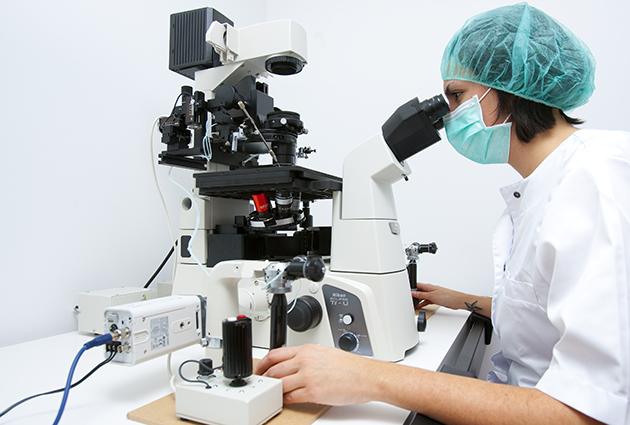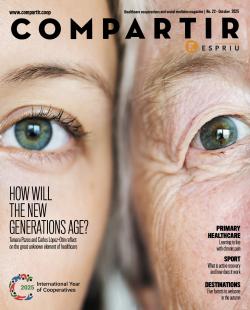
"Our role is to offer scientific information to patients and to emotionally accompany the families on this journey”
Dra. Anna Galindo, Medical Director of Grávida Clínica de Reproducción Asistida.
Grávida Clínica de Reproducción Asistida was created under the umbrella of Assistència Sanitària in 2010. Since then, its use of the latest technologies has made it stand out, along with a human team whose top priority is to help with its patients’ lives. During these more than ten years, they have witnessed the social change occurring and they have know how to adapt to the new needs.
What is the most important challenge for assisted reproduction (AR)?
In the first place, using research to learn to fight against ovarian age. Our challenge is for women of over the age of 40 to be able to use their eggs successfully. Obviously, the mother’s age when bearing her first child is increasing and society cannot reverse this trend. On the other hand, we must accompany and give a solution to all the new family formats. It is a social challenge that goes beyond the normalisation of these families. Finally, we must improve and investigate embryo implantations and make the automation of some processes in the laboratories easier.
When should you visit an assisted reproduction centre?
This will always depend on the social context and the family model. Therefore, for heterosexual couples under the age of 35, they should come after they have been trying unsuccessfully for a pregnancy for a year. If they are over the age of 40, it is advisable to visit a clinic after six months without success. Our great problem is that we cannot repair the ovarian age and this works against many gestations. In addition to this, an assisted reproduction treatment is very different for patients of aged 32, 35 or 40, for example.
For female homosexual couples, it will depend on the woman who wants to become pregnant or donate the egg. We always recommend starting the treatments before the age of 35 years to guarantee greater success. If not, the egg vitrification process is available, which is advisable for women who do not have a partner at present, or who do not want to have children yet, but who do want to have them in the future. Therefore, greater profitability is guaranteed from now to a few years’ time.
What are the most frequent queries made by patients?
They are very varied. Families usually ask for the success rates of the reproduction methods or, for example, whether the hormonal treatments will have future effects on the woman and children.
You have led the human team at Grávida since 2010. How would you define the role and values that the specialists in the clinic must have?
We have two clear roles: offering scientific information and accompanying the families. The treatments are long, at times complicate, journeys. Our role is to closely accompany them on this journey and to help them contain their emotions.
How important is training in AR?
Today, families come to our consulting rooms with too much information that they do not know how to interpret. At Grávida we filter all this data and during the first visit, we adapt it to each patient. There are times when the treatments are clear from the very start and other times when it is more complicated. Our role is to inform and advise, so that the families can make their own decisions.
The new technologies help us to optimise results and reduce the variability of processes between the different laboratories or reproduction centres
Additionally, at Grávida they consider that medicine should be aimed more and more at personalised and individualised treatment, adapted to the patient.
The truth is we have simple cases where success is highly predictable and others that are much more complicated. The difficult cases are becoming more common in our consulting rooms and this is due to the increase in patients over the ages of 35 or 40 years, women with prior surgery, who are receiving a medical treatment… In these cases, in order to be able to optimise the performance, we must make the assisted reproduction treatment highly individual.
Have the technologies changed your daily routine much?
The new technologies help us to optimise results and reduce the variability of processes between the different laboratories or reproduction centres. That is to say, thanks to the progress in this field, our sector moving towards automation. In my opinion, technology is going to allow laboratory techniques to be unified.
Are there diets or habits that can improve a woman’s fertility?
Of course. We live in a society where stress and frantic rhythms lead to cooking at home less and less, along with eating out and eating too many carbohydrates or red meat. The challenge is to get back to the Mediterranean diet which includes many vegetables, pulses or oily fish. Patient nutrition is very important and, at our consultations, we offer nutritional parameters and we have nutritionists.
What role do genetics play in reproductive medicine?
This field has moved forward a great deal, for example, in the prevention of genetic problems that lead to diseases in the offspring. Many patients come to the clinics to discuss their concerns on this point. Currently, genetic tests can be carried out on the embryos, but not in all cases. This is limited by the Spanish law that contemplates when the tests can be carried out.
The vitrification of oocytes allows eggs to be frozen for possible use in the future.
It is advised for many social reasons: for example, a young woman without a partner who does not rule out being a mother, either on her own or with a partner in the future. It is also recommended for patients who are following invasive medical treatments (or who have them scheduled) that reduce, to a great extend, their ovarian reserve and for sex change patients.
How is the work on preservation of fertility being carried out?
Research and work was started years ago on the preservation of fertility, particularly, in oncological patients. Currently, research in fertility preservation in the pre-puberty age is making progress. There is an increase in the families who are considering saving the fertility of their offspring. And finally, as part of the social change, there are many patients who want to postpone their maternity a few more years and this is a good solution for making this become a reality.
Finally, looking to the future, what new developments is Grávida working on?
Our challenge is to always be at the forefront regarding clinical and laboratory technology. And this always involves our wish to give our patients the best facilities. In the post-Covid era, we are working hard on improving access for patients to our specialists and doctors. We want to ensure that remote communication with us is really practical and simple. We are committed to non-personal contact whenever possible, for example, to resolve any queries or comment on the results of an analysis. In this way we avoid our patients having to come to the centre and we can maintain our family-orientated touch, in spite of the fact that the volume of families that we attend has been growing exponentially since our creation.
Dra. Anna Galindo
The Medical Director of Grávida Clínica de Reproducción Asistida since 2010, Doctor Anna Galindo is a regular participant in conferences and talks about the world of reproduction. Her presentations and publications, both national and international show her wide experience in this speciality.





